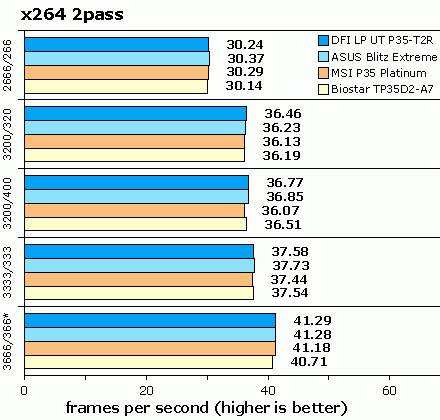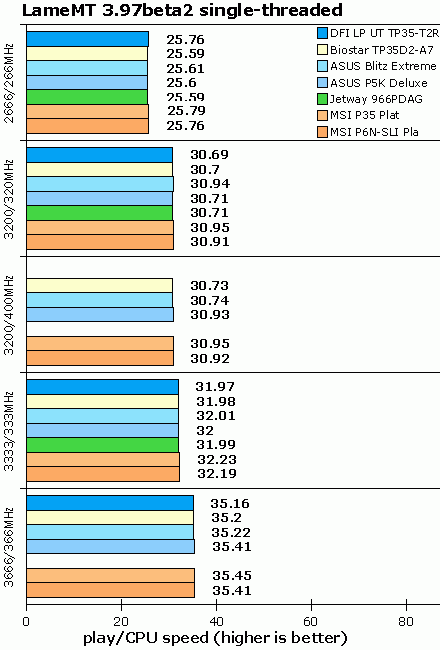Index
Page 5 of 7
Benchmarks:
Please note that different BIOS revisions may give different results. All benches are done with AUTO settings, without altering any BIOS option aside from the CPU VCore and major CL settings. DDR2 speed is always 800MHz, or near to 800MHz when not possible. As stated earlier, we did some tweaking.
Gordian Knot/XVID 1.1.3:
For our Gordian Knot testing we took an PAL episode of "Babylon 5" with a length of 41 minutes, 57 seconds and 8 frames.
We tried to "emulate" the most common usage of Gordian Knot:
1st: We have a perfect master, so we only de-interlace the content and resize it, without any other manipulations. We marked this as "fast."
2nd: You get bad mastering on many DVDs, especially "old" stuff or when the studios are in a hurry for the release. In this case you will want to improve the picture quality, which is done by filtering the content. You can choose from tons of filters for any purposes you can think of. We only used the most common "undot," "FluxSmooth" and "MSharpen." Of course, we also de-interlaced, filters were done before any resizing took place (which is slower). We marked this as "slow."
If you need more information about filters, we recommend reading the doom9.org forum.
Surprisingly, the DFI is weaker than expected.

*Please note the Biostar board is running at 3600MHz.
x264:
x264 is a H.264/AVC codec which supports four threads and is available for free. We used the same "slow" settings as XviD. H.264 gives you a huge advantage in compressing size, and you need much less bitrate to achieve the same or better quality compared to XviD. While the H.264/AVC is much more advanced compared to MPEG2 encoders, now the CPU-power is available to do the encoding in an acceptable time.
You can clearly see that a quad-core brings a massive advantage in encoding speed; the first pass seems to run on only two cores, but the second pass takes advantage of all four cores. With a quad-core you can nearly reach the speed of XivD, which can only use two cores for the time being.
The codec is open source, still in heavy development and you can grab it here.
Here DFI does not show any weakness, which is very strange, because video encoders should perform similarly.

*Please note the Biostar board is running at 3600MHz.
LameMT:
We used the same episode for our MP3-testing. We don't recommend using MP3 for encoding, because AC3 can do the job better. The audio is almost 42 minutes long and it gives us approximately the length of most of album. A measurement in seconds, as many sites use, is useless, because the differences are too small.
We used the built-in play/CPU ratio, which means the CPU is encoding x-times faster then the track-length. Fast memory does not play an important role here. For your convenience we also show you the single-threaded benches. They will be produced with any other L.A.M.E. version, because only LameMT can do more than one thread and take advantage of a second dice.
We used this setting: lamemt --vbr-new -q 2 -V 2 -m j --strictly-enforce-ISO --resample 48.


*Please note the Biostar board is running at 3600MHz.
